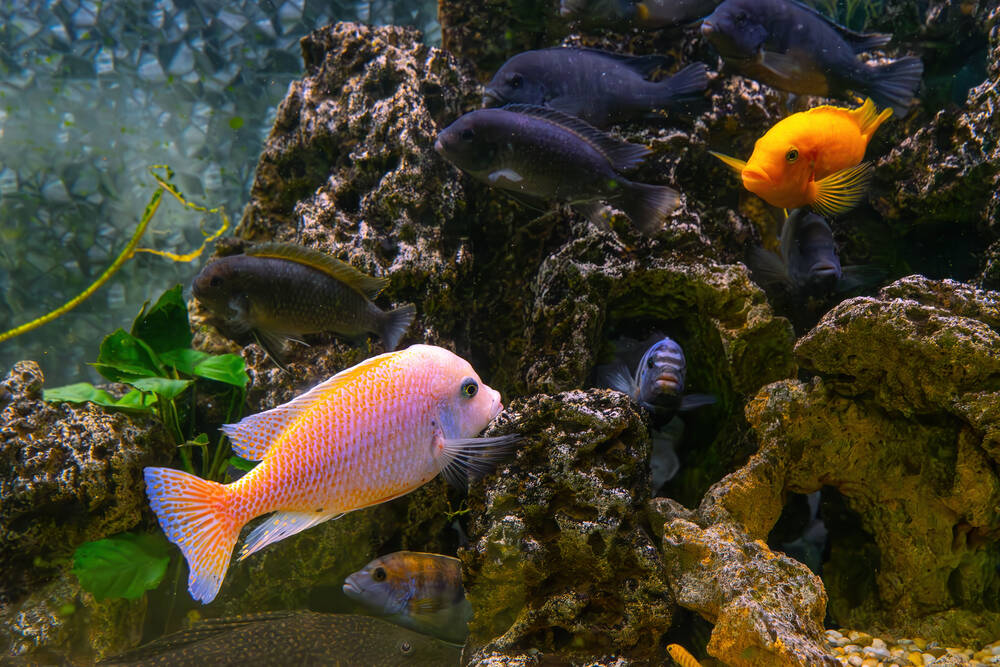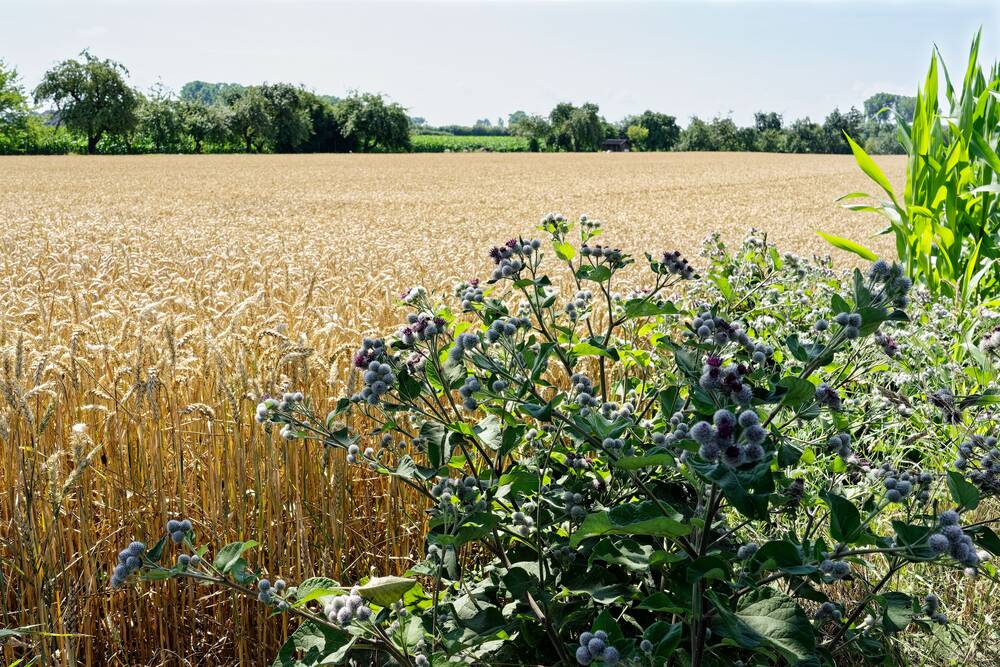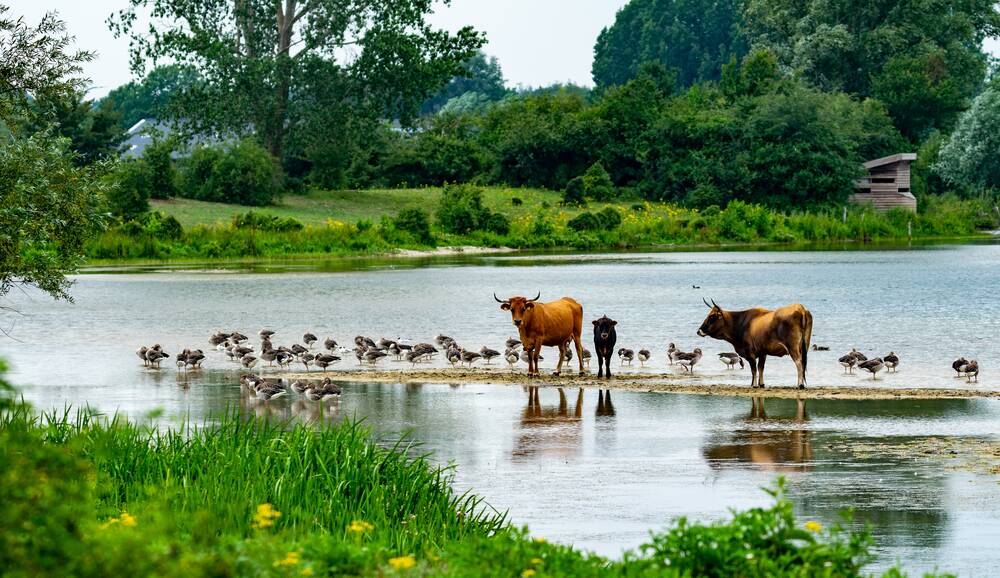Biodiversity is the foundation of life on Earth, supporting plants and animals, ecosystems, and human well-being. As human activities like deforestation, pollution, and climate change accelerate, the natural world faces unprecedented threats.
Protecting biological diversity ensures the resilience of living things, from forests to oceans, while safeguarding essential natural resources like clean air and water.
A thriving environment directly impacts human health and even mental health, offering stress relief and well-being.
Sustainable land use practices can help restore ecosystems, ensuring a balanced and healthy future for all species. Explore how biodiversity shapes our world and why it must be preserved.
Types of Biodiversity
Species Diversity
Species diversity encompasses the variety of entire species on Earth or within an ecosystem. The more complex a food web or chain, the more species diversity it has.
This involves 2 primary concepts: species richness, the number of species, and species evenness, the relative abundance of each species.
Without species diversity, ecosystem collapse would prevail, as ecosystems would not be resilient to changes or external threats.
With high ecosystem biodiversity, there are more ecosystem services, resilience, and productivity.
With species diversity, a stable supply of food for organisms at multiple levels is maintained, and the food web is well-supported.
Species richness is crucial, as it improves the likelihood of pollinators, medicinal plants, and other organisms that contribute largely to human well-being.
Genetic Diversity
Genetic biodiversity refers to the variety of genes in a population or species, encompassing ranges of gene combinations, alleles, and sequences of DNA.
The higher the genetic biodiversity, the higher the ecosystem health and resilience, crucial for a species’ adaptability to new environmental changes like pollution, climate change, or invasive species.
It can come from genetic recombination—sexual reproduction causes new combinations of genes and traits, therefore more diversity. It can also come from natural mutations, where random changes in a DNA sequence creates a new variation of gene order, or the gene flow between different populations.
Ecosystem Diversity
The largest scale of biodiversity; ecosystem diversity covers the variety of ecosystems across the planet, in a set region, geographical context, or within a specific ecosystem.
This could be forests, coral reefs, wetlands, grasslands, oceans, deserts, or thousands of other varied ecosystems.
Ecosystem diversity covers different physical environments, different interactions within ecosystems, and the variety of species and processes that shape those ecosystems’ structures and functions.
The biosphere depends on ecosystem diversity to function, and without it, essential processes like nutrient cycling, climate regulation, and species interactions would collapse.
The higher the ecosystem diversity, the wider range of species that can be supported. It directly equates to biodiversity levels, maintaining the health of our environment, keeping species from extinction, and regulating the Earth’s climate.
Benefits of Biodiversity

1. Builds Resilient Ecosystems
The more biodiversity (worms, great lions, or even just bacteria), the more ecosystem services. These encompass any positive benefit from wildlife or ecosystems provided to people, involving climate regulation, water purification, soil fertility, food and fuel, as well as pollination.
A thriving, biodiverse environment strengthens these ecosystem services, ensuring clean water, stable soils, and balanced nutrient cycles. Natural water filters such as forests and wetlands help trap pollutants, preventing excess runoff into rivers and lakes and maintaining water quality. Species that manage nutrients reduce the risk of algal blooms, which suffocate water life. Resilient ecosystems adapt to environmental changes, recover from disturbances, and sustain life.
They in turn reward us with clean air, fresh water, and abundant food—and their weakening threatens us with pollution, climate instability, and resource scarcity.
2. Regulates Storms, Flooding, and Coastal Erosion
Biodiversity reduces the risks of storms, flooding, and coastal erosion by maintaining ecosystems that act as natural barriers. Wetlands operate like sponges—when it rains a large amount, they suck it up and store it, reducing the risk of floods. High winds and storm surges pose significant risks to coastal communities. Unsustainable land use practices, such as deforestation and urbanisation, can exacerbate these risks.
These biodiverse ecosystems provide essential protection for vulnerable regions. In the Philippines, for instance, the mangrove forests protect villages from typhoons and storm surges. The wetlands slow water flow, preventing flash flooding, erosion, and protecting infrastructure. Their dense root systems absorb excess water and stabilise soil, minimising the impact of extreme weather events.
Similarly, coastal wetlands help maintain the integrity of shorelines. Wetlands essentially stabilise shorelines as wetland plants lock soils in place, such as common reeds, mangroves or cattails. They absorb the energy of the waves, and protect coastal areas from being worn down. As a result, it maintains natural coastline patterns, instead of allowing shorelines to be washed away by currents or waves.
3. Enhances Carbon Sequestration
Before the Industrial Revolution, pre-1750, the concentration of CO₂ in the atmosphere was around 280 parts per million (ppm)—a relatively stable, healthy level.
As of 2024, atmospheric CO₂ levels have reached approximately 424.61 ppm, and if current trends continue, we could surpass 450 ppm well before the 2040s. This would lead to widespread global warming, rising sea levels from melting ice caps, ocean acidification, the loss of essential marine ecosystems, and more frequent extreme weather events.
Protecting and restoring biodiversity is essential for reversing these figures, with ecosystems some of the most significant carbon sinks on the planet. Forests and wetlands can store masses of carbon in both soil and biomass. Mangroves can store up to 10 times the amount of carbon than forests.
Biodiversity is not only critical for species diversity, essential ecosystems, and services humans rely on for just about all parts of life, they are essential in protecting the planet from global warming.
4. Stabilizes Climate Patterns
Biodiversity plays a crucial role in stabilising the climate by maintaining healthy ecosystems that absorb carbon, regulate temperatures, and support resilient food systems. Climate instability is primarily caused by greenhouse gas emissions, ocean changes, and deforestation. This involves clearing out forests for agriculture, monocultures depleting soil biodiversity, overfishing, pollution, and fossil fuel combustion.
From decades of unsustainable practices on a global scale, weather patterns become unpredictable, including rising global temperatures, disruptions in weather cycles, and extreme weather events.
For example, Typhoon Haiyan in 2013 was exacerbated by the destruction of mangrove forests and coastal wetlands from ocean warming and deforestation. These habitats usually absorb storm surges and reduce coastal erosion.
Another example were the Australian bushfires. The increased temperatures, prolonged droughts, and destruction of vegetation that was fire-resistant contributed to the length of the event. They lasted from September 2019 to March 2020.
Restoring biodiversity is crucial for combating climate instability and mitigating the likelihood of extreme, harmful weather events.
5. Strengthens Disease Resistance
A key benefit of biodiversity is strong, healthy, and varied crops, which contribute to greater resilience against diseases as they adapt to changing conditions and threats.
It brings natural pest controls, such as ladybirds and birds of prey, reducing the need for chemical pesticides and preventing crop diseases and pests from significantly harming yields. With sufficient nutrient cycling and well-structured soil, agricultural productivity increases.
As a result, farmers can rely on more sustainable and stable food production, such as a renewable approach in place of a traditional, harmful approach.
6. Improves Food Security
A significant benefit—moreso necessity—of biodiversity is our food security.
Without biodiversity, declines in crucial species such as pollinators leads to less production of crops like nuts, fruits, and vegetables. These help prevent malnutrition, risk of disease, premature death, and weakened immune systems.
Overfishing leads to declines in fish populations, which many communities rely on for a protein source. In West Africa, for instance, depleted fish stocks have negatively impacted the livelihoods of millions of people, from losses of jobs, to people’s inability to afford rising fish prices.
Many communities have taken charge of this, introducing managed fishing zones to restore biodiverse fish stocks, and initiatives like the West Africa Regional Fisheries Program (WARFP) which curbs illegal fishing and encourages sustainability.
7. Controls Agricultural Pests Naturally
Biodiversity is crucial for natural pest control. Predators like birds, amphibians, and bats feed on agricultural pests, allowing farmers to not depend on chemical fertilisers that harm nature more in the long run. Healthy ecosystems naturally sustain food production while minimising environmental harm.
When chemical pesticides are used, containing toxic compounds, they degrade the soil and reduce the amounts of animals living within it (such as earthworms and microorganisms).
Over decades of reuse, farmers are left with infertile land and must increase chemical usage or abandon farming. Prioritising biodiversity is essential for sustainable agriculture and food security as a whole.
8. Purifies and Filters Water Sources

Biodiversity provides some of the best habitats for water filtration and purification, essential to thriving biodiversity on the planet. Some ecosystem services of wetlands, for example, prevent water source contamination, shield ecosystem health and challenge the need for artificial water treatments.
These ecosystems filter water by trapping pollutants in the soil, such as pesticides from agricultural runoff. While plants absorb water and essential nutrients from the soil, harmful substances can also be captured and broken down by microbes. Additionally, sediments—including soil particles, organic matter, and heavy metals—settle at the bottom, preventing them from polluting nearby water bodies.
9. Maintains Clean Air Quality
Biodiversity plays a crucial role in air purification, with forests, wetlands, and plant-rich ecosystems acting as natural air filters.
Trees absorb carbon dioxide, release oxygen, and trap pollutants like particulate matter, improving air quality while mitigating climate change’s harmful effects. Thriving, biodiverse ecosystems sustain cleaner, healthier air.
Methods prioritizing biodiversity, like regenerative agriculture, enhance soil fertility by using natural, self-sustaining techniques such as cover cropping, composting, and no-till farming.
Traditional managed crop fields often rely on monocultures, where a single crop is repeatedly grown in rows. However, modern approaches recognize the value of crop diversity, such as polyculture and agroforestry, which create more resilient, sustainable ecosystems and help secure long-term environmental health.
10. Preserves Genetic Diversity for Future Use
Biodiversity maintains a wide range of microbial, animal, and plant species, each distinctively adapted to environmental challenges.
Preserving biodiversity preserves ecosystem resilience—without it, species would be wiped out by any external harm. It allows species to be adaptable, reducing the risk of them becoming an endangered species by ensuring there’s a varied pool of genes full of potential survival traits.
If one species had all the same genes, not only would that lead to harmful inbreeding and population collapse, but the second a disease was added to the equation that the species couldn’t combat, you’d witness a detrimental species-wide wipeout.
For example, grey wolves have high genetic diversity in varied environments and can thrive across many ecosystems, whereas African cheetahs do not, making them vulnerable to disease and extinction.
11. Drives Nutrient Cycling in Ecosystems
When nutrients move from living organisms (i.e. plants, animals, and microbes) to dead matter (i.e. decaying leaves, carcasses, and organic waste), this is nutrient cycling. It ensures essential elements such as phosphorus, nitrogen, and carbon continue to support the growth of living organisms.
Biodiversity drives this essential function through various processes: fungi and earthworms decompose organic matter, bacteria make nitrogen usable for plants, mycorrhizal fungi form symbiotic relationships with roots, and herbivores recycle nutrients through grazing and manure deposition.
Without nutrient cycling, ecosystems would become imbalanced. It’s essentially the food chain breaking down to the atomic level—then rebuilding itself again.
12. Provides Essential Physical Resources
From timber and wood to fibers and textiles, essential medicines to food and agriculture—countless physical resources come entirely from biodiversity. Ever since we started making tools from natural materials back in prehistoric times, humans utilised what was available in abundance to them.
A significant decline in biodiversity would lead to far-reaching consequences. First, food and water resources would become scarcer, potentially leading to a decrease in population due to resource shortages. Economic collapse could loom across a wide array of industries, from agriculture to pharmaceuticals.
Biodiversity is fundamental for preserving ecosystems and ensuring human well-being.
13. Offers Medicinal and Pharmaceutical Resources
Natural products and their derivatives represent over one-third of all FDA-approved new molecular entities. Cancer, for instance, is one of the top causes of deaths worldwide, however over 60% of current anticancer drugs are derived from natural sources (microorganisms, marine organisms, and plants). For example, Pacific yew is endangered due to its role in the cancer-fighting drug Taxol.
Aspirin comes from willow tree bark, morphine comes from the opium poppy, and digoxin (heart condition medicine) comes from foxglove.
Did you know that scientists estimate less than 5% of the rainforests’ plants have been studied for medicinal value? Though this is the case, their ecosystems are being rapidly destroyed, with 50-100 acres of rainforest predicted to be lost every minute. Over 80% of developing countries rely primarily on traditional medicine, hence depend on biodiversity for their livelihoods.
14. Supports Pollination and Crop Production

Biodiversity is essential for maintaining pollination, a critical ecosystem service that supports both natural environments and global food production.
The human race largely depends on bees for pollinating our food and keeping it secure, hoverflies for pollinating plants and consuming pests, butterflies for flower pollination, moths for night-time pollination, and wasps for some cases of plant pollination.
Pollinators help achieve more visually appealing produce, as incomplete and misshapen crops grow when they have not been adequately pollinated.
15. Balances and Regulates Natural Systems
Biodiversity balances natural systems such as ecosystems and food chains by maintaining species interactions, such as the predator-prey relationship.
Without this balance, ecosystem collapse may happen. Biodiversity restoration is crucial because it ensures ecological stability, supports life-sustaining processes, and enhances resilience against environmental changes.
16. Sustains Economies and Livelihoods
A recent study revealed that around 55% of the world’s GDP—the monetary value of all final goods and services in a country over a set time period—is either moderately or highly dependent on nature.
That means that when nature fails, majorities of industries, and subsequent livelihoods, could fail too. Some of the most nature-dependent industries include agriculture, forestry, fishing and aquaculture, tourism, and pharmaceuticals.
If human-led biodiversity loss leads to the collapse of many central industries, there could be widespread job loss and economic hardship.
Many rural communities would face cultural erosion, particularly fishing and farming communities, whose traditions, culture, and ways of life are deeply embedded in their livelihoods. Where livelihoods are directly connected to rural jobs, communities could suffer with rising costs and food scarcity.
The lack of diversity of jobs might encourage people to flee from rural areas with degraded quality of life, to urban areas with more opportunity. If this happened on a major scale, it could cause overcrowding, unemployment, poverty, public health challenges, environmental degradation, and economic ruptures.
17. Protects Natural Habitats and Wildlife
Deforestation, pollution, climate change, and other human impacts have led to biodiversity loss on a major scale, causing habitat loss, leading to the disappearance of species, and even extinction.
By restoring habitats such as wetlands or forests, it allows ecosystems to rebuild and recover, meaning that wildlife can return, and ecosystems regain their balance.
While biodiversity has been significantly hit over the past century, many organisations are actively working to conserve ecosystems and bring species back from extinction, through breeding programs, habitat restoration, and legal protections.
18. Boosts Overall Health and Wellbeing
With ecosystems disrupted and unstable, the risk of zoonotic diseases arises—meaning diseases that transfer from animals to humans.
The disruption of ecosystems leads to losses in predators and habitat fragmentation. This lack of ecological balance can instead boost populations of bats or rodents, which mostly carry the zoonotic diseases, increasing the likelihood of human illness.
Nature is also crucial for mental health, proven to benefit anxiety, depression, and stress, meaning that biodiversity loss could reduce wellbeing in humans.
19. Provides Cultural, Spiritual, and Recreational Value
Significantly, it can lead to losses of cultural identities, with many rural and Indigenous communities dependent on biodiversity for their traditions, spiritual practices, and ways of life. These communities often hold deep, generational knowledge about their local ecosystems, integral to their cultural heritage. Beyond cultural impacts, biodiversity loss can also reduce their access to vital resources like food, medicine, and clean water.
More Information
https://www.santander.com/en/stories/nature-biodiversity
https://www.resources.org/archives/the-economics-of-biodiversity
https://www.enelgreenpower.com/learning-hub/sustainable-development/biodiversity
https://www.unep-wcmc.org/en/news/earths-biodiversity-depends-on-the-worlds-forests
https://besjournals.onlinelibrary.wiley.com/doi/full/10.1111/1365-2745.13180
https://www.decadeonrestoration.org/stories/soil-biodiversity-contributions-and-threats
https://www.foodnavigator.com/Article/2024/11/07/Biodiversity-and-food-security

